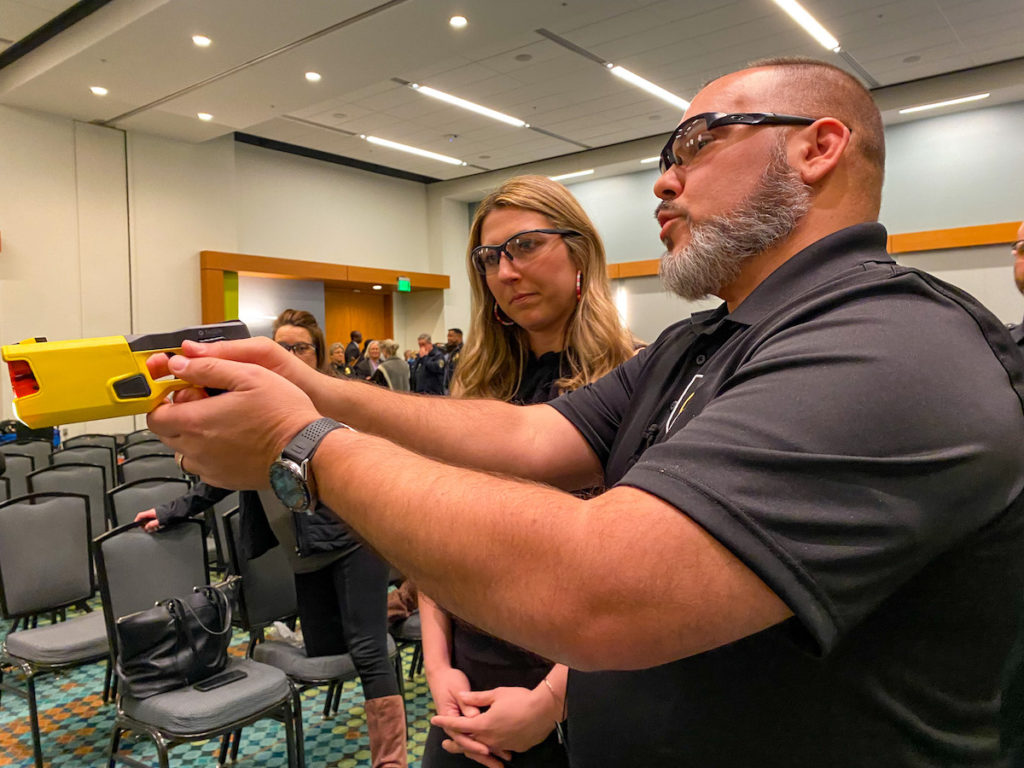
Tasers are supposed to help officers stop someone without shooting them. That’s why the Metro Nashville Police Department is spending about $6 million for new ones.
The chief has called the old model of Tasers “obsolete,” but he also acknowledges that more effective Tasers won’t necessarily prevent deadly force.
The police department showed off its brand-new devices at a demonstration last week. After a brief presentation about the mechanics of the technology, pops and buzzes coursed through the room at the Music City Center. Reporters and community members held the yellow Axon Taser 7 in their hands, pulled the trigger and watched as it sent bursts of electricity into coils of wire that propelled through the air, then pierced a body-sized target.
https://twitter.com/samanthaellimax/status/1502079756199677965?s=20&t=94eZMlSsHT6aeYYfCoodxQ
Tasers are what police call a tool for less-lethal force. That means they can hurt someone. In some cases, they might even kill them. But the risk of death from a Taser is much smaller than from a bullet.
“We have to look to de-escalating situations,” Chief John Drake says. “These Tasers allow us that ability to de-escalate more efficiently.”
The chief says the new Tasers are more accurate. The thumbtack-sized probes can grab onto skin or clothing more easily. The new cartridges also allow officers to now get two shots instead of one. So if they miss, they can try again instead of resorting to some other type of force, like a gun.
There’s also an option to press a button that triggers a “warning arc” — the sound of surging electricity officers can activate to persuade someone to comply with their orders before getting Tased.
“This is far and above superior to what we have right now,” Drake says.
Many Nashvillians are urging police to use their firearms less, after officers shot a record-setting 10 people last year — seven fatally. In January, multiple officers fired at a man on the interstate, killing him.
But in most of those cases, it would have been against department training to use a Taser. In nearly all the recent shootings by police, the other person had a gun. And Drake says officers are taught not to pull a Taser when there’s a chance they could get shot.
“If a person pulls out a gun, that’s a lethal option that they have, and we have to transition to that, because at that point, they can fire from any range and we can’t,” he says.
Andrew Delke, the first Nashville police officer to be charged with first-degree murder for an on-duty shooting, was previously criticized by his supervisors for pulling his Taser instead of his gun during an encounter with someone who was armed.
Records show Delke’s sergeant told him he would have been “justified” to use his gun the night that he took out his Taser instead. His precinct commander wondered if the department aught to adjust its training to ensure that officers not let “the possibility of media attention override our training and policy.”
About nine months later, Delke shot and killed Daniel Hambrick.
 Samantha Max WPLN News (File)
Samantha Max WPLN News (File)“Our main goal is to de-escalate a situation,” Sgt. Jason Spencer says. “If we don’t have to use force, we consider that a win.”
MNPD has stressed the importance of training as it equips the entire force with new Tasers.
Officers will go through several hours of instruction to learn how and when to use them. They will go through virtual reality simulations and get tips to navigate situations when someone has a mental illness, Alzheimer’s or another condition that could complicate an encounter.
Sgt. Jason Spencer from the training academy says the focus will be on empathy. He even recommends that officers try getting Tased themselves at the end of class. He says it builds credibility — and dissuades officers from using them too often.
“Then they know what it feels like,” he says. “You’re not going to have someone go, ‘Oh, yeah, well, ha!’ because they realize how much it hurts.”

